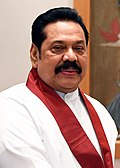| |||||||||||||||||||||||||||||||||||||||||||||||||||||||||||||||||||||||||||
All 225 seats in the Parliament of Sri Lanka 113 seats needed for a majority | |||||||||||||||||||||||||||||||||||||||||||||||||||||||||||||||||||||||||||
|---|---|---|---|---|---|---|---|---|---|---|---|---|---|---|---|---|---|---|---|---|---|---|---|---|---|---|---|---|---|---|---|---|---|---|---|---|---|---|---|---|---|---|---|---|---|---|---|---|---|---|---|---|---|---|---|---|---|---|---|---|---|---|---|---|---|---|---|---|---|---|---|---|---|---|---|
| Registered | 17,140,354 [1] | ||||||||||||||||||||||||||||||||||||||||||||||||||||||||||||||||||||||||||
| Turnout | 68.93% ( | ||||||||||||||||||||||||||||||||||||||||||||||||||||||||||||||||||||||||||
| |||||||||||||||||||||||||||||||||||||||||||||||||||||||||||||||||||||||||||
| |||||||||||||||||||||||||||||||||||||||||||||||||||||||||||||||||||||||||||
| This article is part of a series on the |
| Politics of Sri Lanka |
|---|
 |
| Part of a series on the |
| Aragalaya |
|---|
 |
| Background |
| Economic crisis (2019–present) |
| Political crisis (2022–present) |
| Legacy |
Parliamentary elections were held in Sri Lanka on 14 November 2024 to elect 225 members to the new parliament. The 16th Parliament of Sri Lanka was dissolved on 24 September 2024. [3] [4] [5] The submission of nominations for the election commenced on 4 October and concluded on 11 October 2024 at 12:00. [6] [7]
The result of the election was a landslide victory for the left-wing National People's Power coalition led by recently elected president Anura Kumara Dissanayake. [8] The NPP won 159 seats, more than any Sri Lankan political party in history, the second highest proportion of seats in the nation's history, and won every district except Batticaloa. This was the first election since 1977 where a single party managed to achieve a supermajority and the first time the Jaffna District was won by a non-Tamil political party. [9] This election also saw a record in women's representation with 21 female MPs elected, the highest in Sri Lanka's parliamentary history, [10] and a record number of more than 150 MPs are first-timers. [11]
Following the election, the newly elected 17th Parliament of Sri Lanka was inaugurated on 21 November 2024. [12] [13]

















